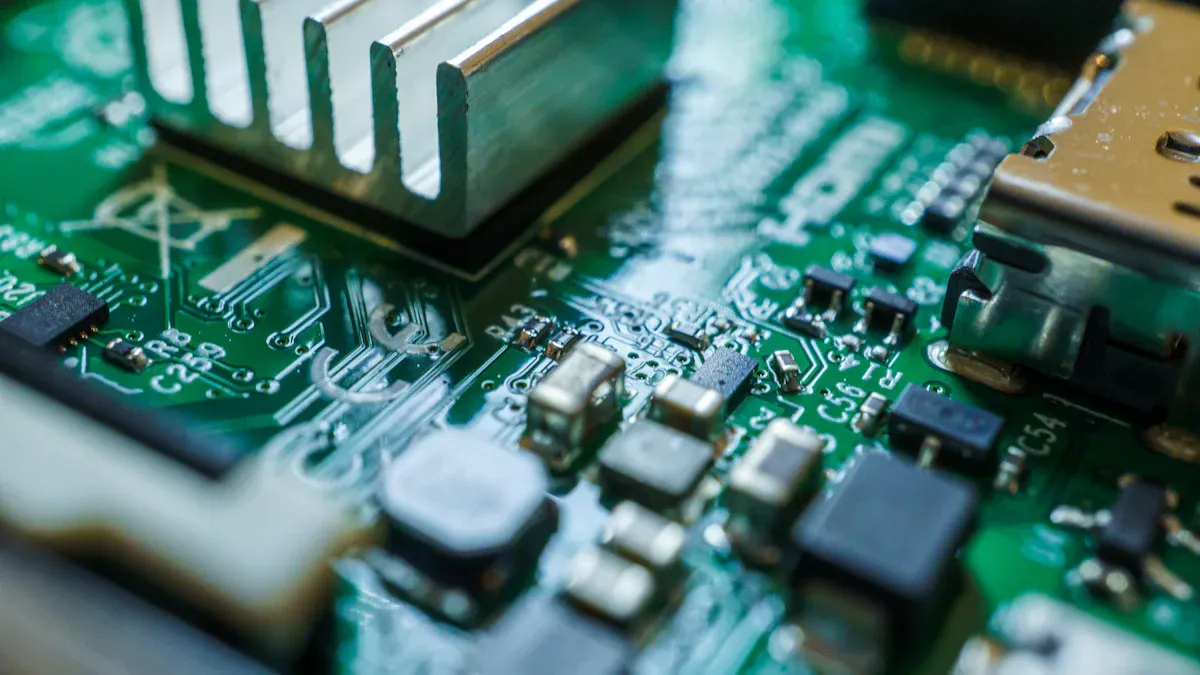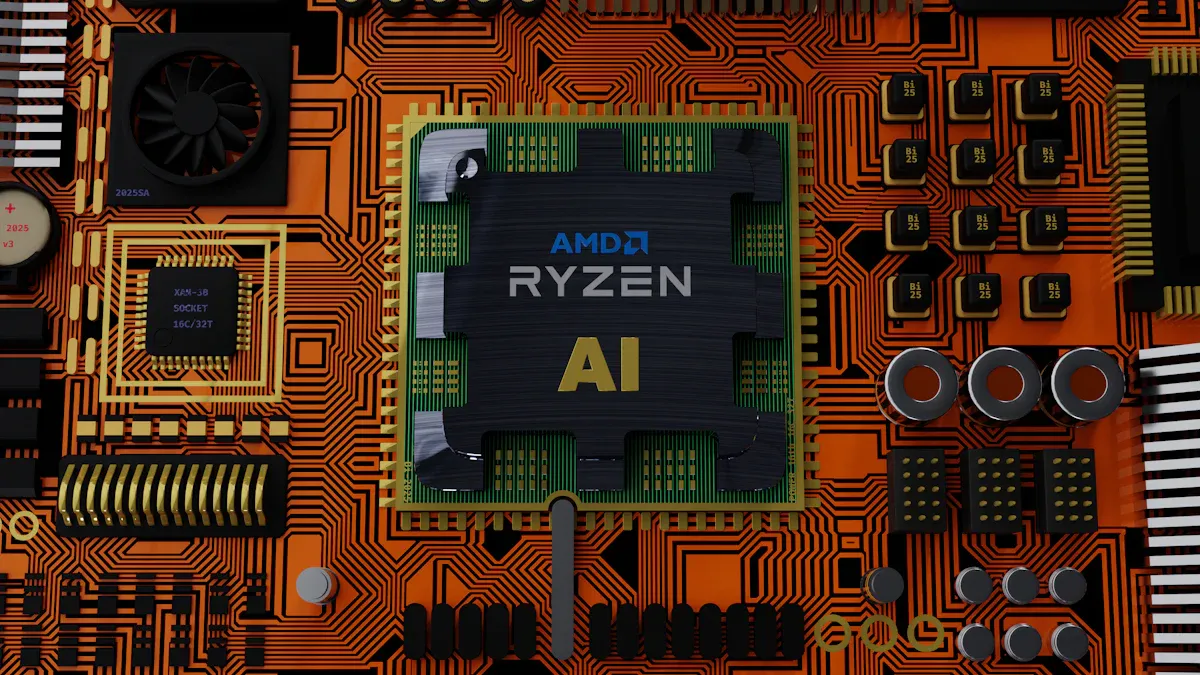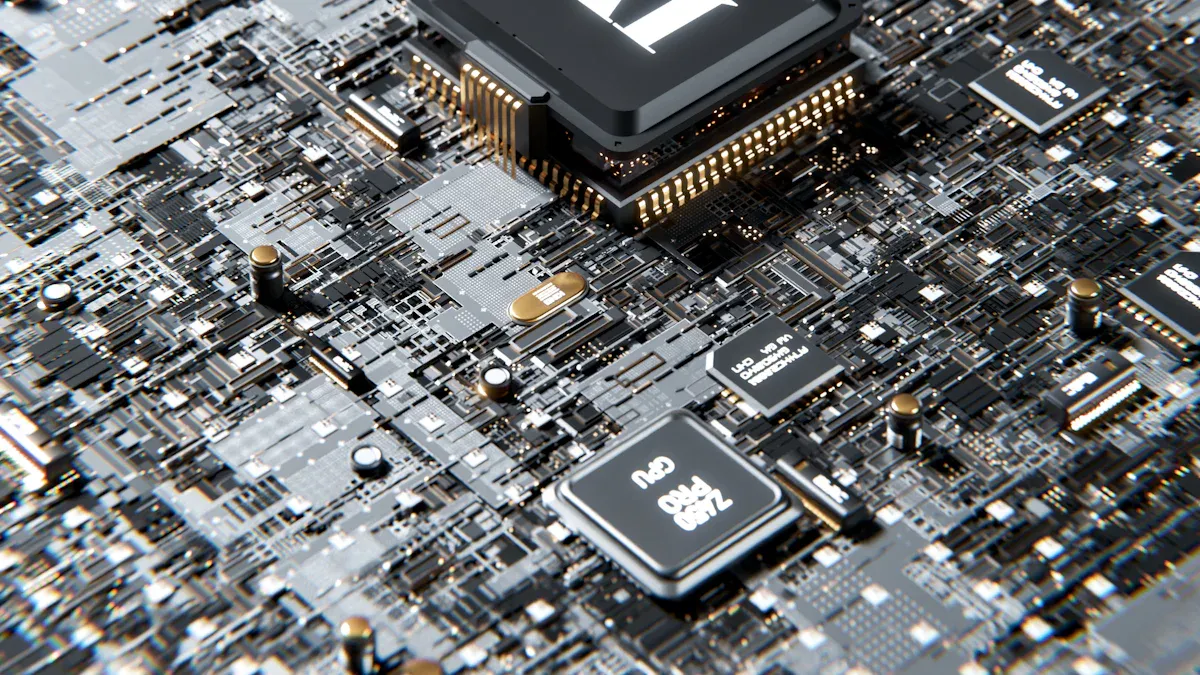MCU 32-bit ARM Cortex Features You’ll Love

When it comes to microcontrollers, the MCU 32-bit ARM Cortex stands out as a game-changer. Its powerful architecture ensures exceptional performance while keeping power consumption low. This balance makes it ideal for modern applications. For example:
The market for 32-bit MCUs, valued at $2,186 million in 2021, is expected to grow to $6,522 million by 2030, reflecting a 14% CAGR.
These microcontrollers are crucial for IoT systems, handling multiple peripherals efficiently and dominating industrial uses.
With their scalability and energy-efficient design, they have become the go-to choice for embedded systems, IoT devices, and beyond.
Key Takeaways
MCU 32-bit ARM Cortex microcontrollers are fast and use little power. They are great for IoT and small device projects.
Cool features like adjustable speeds and floating-point math make them better at tough jobs.
They save energy with low-power modes and smart voltage control, helping batteries last longer in gadgets.
Built-in connections and tools make it easy to link with other devices and sensors.
Helpful tools and a strong community let developers build creative projects quickly.
High-Performance Features of MCU 32-bit ARM Cortex

Advanced ARM Cortex Core Architectures
The ARM Cortex core architectures are designed to deliver exceptional performance for modern microcontroller applications. You’ll find features like dual-issue 32-bit designs and advanced pipeline structures that enhance processing efficiency. For example, the Cortex-M85 architecture offers 20% higher AI throughput compared to the Cortex-M55. It also achieves 30% more throughput per clock cycle than the Cortex-M7.
Here’s a comparison of key features between Cortex-M85 and Cortex-M7:
Feature | Cortex-M85 | Cortex-M7 |
|---|---|---|
AI Throughput | 20% more than Cortex-M55 | N/A |
Throughput per Clock Cycle | 30% more than Cortex-M7 | N/A |
Architectural Features | Pointer authentication, BTI | N/A |
Design Type | Dual-issue 32-bit | Dual-issue 32-bit |
Pipeline Length | Longer than other M-series | N/A |
Vector Processing Extensions | Helium | N/A |
These advancements make MCU 32-bit ARM Cortex microcontrollers ideal for applications requiring high-speed data processing and AI capabilities.
Scalable Clock Speeds for Diverse Applications
Clock speed scalability is one of the standout features of MCU 32-bit ARM Cortex microcontrollers. You can adjust the clock speed to match the requirements of your application, whether it’s a low-power IoT device or a high-performance industrial system. This flexibility ensures optimal performance without compromising energy efficiency.
For example, in low-power modes, the clock speed can be reduced to conserve energy, while in high-performance modes, it can be increased to handle demanding tasks. This adaptability makes these microcontrollers suitable for a wide range of applications, from wearable devices to automotive systems.
Support for Floating-Point and DSP Instructions
ARM Cortex microcontrollers excel in handling complex mathematical operations, thanks to their support for floating-point and DSP (Digital Signal Processing) instructions. These features are particularly useful for applications like signal processing, audio processing, and real-time control systems.
Floating-point operations support half, single, and double-precision arithmetic, ensuring high computational accuracy.
The floating-point implementation complies with IEEE-754 standards, guaranteeing reliability across various applications.
DSP instructions enhance the performance of numerical algorithms, making them faster and more efficient.
Processors like Cortex-M4, Cortex-M33, and Cortex-M7 include optional floating-point units to boost signal processing capabilities.
These features enable MCU 32-bit ARM Cortex microcontrollers to handle demanding tasks with precision and speed, making them indispensable for modern embedded systems.
Power Efficiency in MCU 32-bit ARM Cortex
Energy-Efficient Design for Battery-Powered Devices
Energy efficiency plays a critical role in battery-powered devices, and MCU 32-bit ARM Cortex microcontrollers excel in this area. These microcontrollers are designed to minimize energy consumption while maintaining high performance. By leveraging features like Direct Memory Access (DMA) and optimized hardware interfaces such as SPI, they reduce data movement overhead. This approach not only improves performance but also extends battery life significantly.
For instance, wearable devices that use DMA-based storage systems experience reduced memory usage and faster communication times. This results in lower energy consumption, making these microcontrollers ideal for applications where battery life is crucial. Whether you're designing a fitness tracker or a medical monitoring device, the energy-efficient design of ARM Cortex microcontrollers ensures your product lasts longer on a single charge.
To validate these claims, benchmarks like ULPBench and EnergyMonitor provide a standardized way to measure energy efficiency. Here's a quick overview:
Benchmark | Description |
|---|---|
ULPBench | Developed by EEMBC to evaluate energy consumption of ultra-low power MCUs. |
EnergyMonitor | Measures energy consumption under specific conditions (3V, ≤28 mA). |
EEMBC | Provides a framework for comparing energy efficiency claims of MCUs. |
These benchmarks highlight the superior energy efficiency of ARM Cortex microcontrollers, making them a reliable choice for battery-powered applications.
Multiple Low-Power Modes for Optimized Usage
MCU 32-bit ARM Cortex microcontrollers offer multiple low-power modes to optimize energy usage. These modes allow you to tailor power consumption based on the operational requirements of your application. For example, in sleep mode, the microcontroller shuts down non-essential components while keeping critical functions active. This reduces energy consumption without compromising functionality.
You can also use deep sleep or standby modes for even greater energy savings. These modes disable most of the microcontroller's functions, leaving only the essential ones running. When the system needs to wake up, it does so quickly, ensuring minimal delay. This flexibility makes ARM Cortex microcontrollers suitable for IoT devices, where energy efficiency is a top priority.
By utilizing these low-power modes, you can extend the operational life of your devices, reduce heat generation, and lower overall energy costs. Whether you're working on a smart home system or an industrial sensor network, these features help you achieve optimal energy efficiency.
Dynamic Voltage and Frequency Scaling (DVFS)
Dynamic Voltage and Frequency Scaling (DVFS) is another powerful feature of MCU 32-bit ARM Cortex microcontrollers. DVFS allows you to adjust the voltage and clock frequency dynamically based on the workload. This ensures that the microcontroller uses only the energy it needs, reducing power consumption significantly.
For example, when the system is idle or performing less demanding tasks, DVFS lowers the clock frequency and voltage. This reduces energy usage without affecting performance. Conversely, during high-performance tasks, the system increases the clock frequency to meet the demand.
Statistical analysis shows the impact of DVFS on power consumption:
Configuration Tuples | SYSCLK Output (MHz) | |
|---|---|---|
{50, 25, 216} | 100 | 50% |
{16, 8, 100} | 100 | 50% |
This data demonstrates how DVFS can cut power consumption by up to 50%, making it an essential feature for energy-efficient designs. Whether you're developing a portable medical device or an industrial automation system, DVFS helps you balance performance and energy efficiency effectively.
Peripheral Integration in MCU 32-bit ARM Cortex

Built-In Communication Interfaces (UART, SPI, I2C, etc.)
MCU 32-bit ARM Cortex microcontrollers come equipped with built-in communication interfaces like UART, SPI, and I2C. These interfaces simplify data exchange between the microcontroller and external devices, making them essential for embedded systems.
UART: This interface is widely used in GPS modules, Bluetooth modules, and environmental sensors. It supports configurable transfer speeds up to 1 Mbps and includes a parity bit for basic error checking.
SPI: Known for its high-speed capabilities, SPI can exceed 100 MHz and supports full-duplex communication. It is ideal for connecting high-speed peripherals like displays and sensors.
I2C: This interface is perfect for low-speed devices such as EEPROMs and microcontrollers. It includes flow control and error handling, ensuring reliable data transfer.
Protocol | Speed Characteristics | Reliability Features |
|---|---|---|
UART | Up to 1 Mbps | Parity bit for error checking, less robust |
SPI | Exceeds 100 MHz, full-duplex | No built-in error detection, relies on higher protocols |
I2C | Lower speed, multi-master mode | Flow control and error handling included |
These interfaces enhance the versatility of ARM Cortex microcontrollers, enabling seamless integration with a wide range of devices.
Advanced Timer and PWM Capabilities
Timers and PWM (Pulse Width Modulation) functionalities in MCU 32-bit ARM Cortex microcontrollers offer exceptional performance and precision. These features are crucial for applications like motor control, LED dimming, and signal generation.
For instance, ARM Cortex-M4-based microcontrollers include 12 general-purpose 16-bit timers, 2 PWM timers, and 2 general-purpose 32-bit timers. This configuration allows you to handle multiple timing tasks simultaneously. Additionally, the PWM timers provide precise control over duty cycles, ensuring smooth operation in motor control systems.
Feature | Details |
|---|---|
Timers | 12 general-purpose 16-bit, 2 PWM, 2 general-purpose 32-bit timers |
Performance | 210 DMIPS/1.25 DMIPS/MHz (Dhrystone 2.1) |
Applications | Motor control, LED dimming, signal generation |
These advanced timer and PWM capabilities make ARM Cortex microcontrollers a reliable choice for time-sensitive applications.
Integrated ADCs, DACs, and Sensor Interfaces
ARM Cortex microcontrollers integrate ADCs (Analog-to-Digital Converters), DACs (Digital-to-Analog Converters), and sensor interfaces to streamline data acquisition and processing. For example, the EFM32 Giant Gecko Series includes 3 × 12-bit ADCs with up to 24 channels and 2 × 12-bit DACs. These components enable accurate signal conversion, which is vital for sensor-based applications.
The microcontrollers also feature PDM (Pulse Density Modulation) sensor interfaces, making them suitable for audio processing and environmental monitoring. With ultra-low power consumption and cryptographic hardware engines, these microcontrollers excel in battery-powered and secure systems.
Feature | Description |
|---|---|
Integrated ADCs and DACs | Yes |
PDM Sensor Interface | Included |
Application Suitability | Ideal for battery-powered systems requiring high performance and low energy use |
These integrated peripherals simplify system design and enhance the functionality of MCU 32-bit ARM Cortex microcontrollers.
Memory and Storage Features in MCU 32-bit ARM Cortex
Flexible Flash and RAM Configurations
MCU 32-bit ARM Cortex microcontrollers offer flexible flash and RAM configurations to meet diverse application needs. You can choose from a wide range of memory sizes, ensuring your design has just the right amount of storage. For instance, flash memory sizes often range from 32 KB to several megabytes, while RAM options can go up to 1 MB or more. This flexibility allows you to optimize your system for cost, performance, and power efficiency.
Flash memory provides non-volatile storage, making it ideal for storing firmware and application code. RAM, on the other hand, ensures fast data access during runtime. Together, these memory types create a balanced system that supports both stability and speed. Whether you're building a simple IoT sensor or a complex industrial controller, these configurations give you the freedom to scale your design.
External Memory Support for Complex Applications
When your application demands more memory than the built-in options, external memory support becomes essential. MCU 32-bit ARM Cortex microcontrollers excel in this area, offering advanced features to handle external memory efficiently:
The Cortex-A320 supports external memory configurations, enhancing memory access performance for complex applications.
It includes up to 64KB L1 caches and up to 512KB L2 caches, which improve memory management.
The 256-bit AMBA5 AXI interface enables high-bandwidth communication with external memory, making it suitable for demanding tasks like AI processing and multimedia applications.
These features ensure your system can handle large datasets and complex computations without compromising performance.
Secure Boot and Memory Protection Features
Security is a top priority in modern embedded systems, and MCU 32-bit ARM Cortex microcontrollers deliver robust protection. Secure boot ensures only trusted code runs on your device by verifying each boot stage cryptographically. This process prevents unauthorized access and modifications.
Evidence Description | Key Points |
|---|---|
Secure boot protects embedded systems from unauthorized access and modifications. | It verifies each boot stage cryptographically, ensuring only trusted code runs on the device. |
Implementation challenges exist but are essential for a robust security strategy. | Adapting secure boot to evolving technology and threats is crucial for device integrity. |
Firmware signatures must be programmed and securely stored. | Typically, these signatures are stored in one-time programmable and lockable fuses. |
Private keys are essential for signing codes. | Secure management of these keys, especially during firmware updates, is critical. |
Each boot stage must verify the signature of the next stage. | This process ensures the integrity of the boot process. |
Additionally, features like TrustZone security and stack protection enhance system reliability. TrustZone separates the system into Secure and Non-Secure states, safeguarding sensitive operations. These capabilities comply with rigorous standards like ISO/SAE 21434 and IEC 62443, ensuring your device meets modern security requirements.
Development Ecosystem for MCU 32-bit ARM Cortex
Wide Range of Development Tools and IDEs
You’ll find a robust selection of development tools and IDEs tailored for MCU 32-bit ARM Cortex microcontrollers. These tools simplify the design process, allowing you to focus on innovation rather than troubleshooting. Popular options include Keil MDK, IAR Embedded Workbench, and ARM Development Studio. Each tool offers features like debugging, code optimization, and simulation, ensuring your projects run smoothly.
For example, Keil MDK provides a user-friendly interface and supports advanced debugging features like trace analysis. IAR Embedded Workbench excels in code optimization, helping you achieve high performance with minimal resource usage. ARM Development Studio integrates seamlessly with ARM processors, offering comprehensive support for complex applications.
These tools cater to developers of all skill levels, whether you’re a beginner or an expert. Their intuitive interfaces and extensive libraries make it easier to bring your ideas to life.
Compatibility Across ARM Cortex Families
ARM Cortex microcontrollers offer unmatched compatibility across their family of processors. This feature allows you to scale your designs effortlessly, whether you’re working on a simple IoT device or a sophisticated robotic system. For instance, the Cortex-A53 and Cortex-A76 processors meet safety and efficiency requirements while maintaining compact designs.
This compatibility ensures you can reuse code and hardware designs across different projects, saving time and resources. It also simplifies upgrades, letting you transition to higher-performance processors without starting from scratch. Whether you’re designing for CubeSats or planetary rovers, ARM Cortex microcontrollers adapt to your needs. Their motor control capabilities make them ideal for tasks like satellite antenna positioning and rover locomotion, showcasing their versatility in demanding environments.
Extensive Community and Documentation Support
The development ecosystem for MCU 32-bit ARM Cortex microcontrollers thrives on community engagement and comprehensive documentation. You’ll benefit from resources like the ARM Connected Community, where users and partners collaborate to solve design challenges.
A thriving forum community provides support throughout the design process, ensuring you never feel stuck. ARM’s technical support team consistently achieves a 95% customer satisfaction score, reflecting their commitment to helping developers succeed.
Documentation for ARM Cortex microcontrollers is detailed and accessible, covering everything from hardware specifications to software libraries. This wealth of information empowers you to make informed decisions and troubleshoot effectively. Whether you’re a hobbyist or a professional, the extensive support network ensures your projects stay on track.
MCU 32-bit ARM Cortex microcontrollers offer a unique combination of performance, efficiency, and scalability. Their advanced architectures, energy-saving features, and integrated peripherals make them ideal for a wide range of applications. From IoT devices to industrial automation, these microcontrollers adapt to diverse needs with ease.
The global ARM microcontroller market, valued at 17.24 billion USD in 2023, reflects their growing demand.
Single-core designs excel in low-power tasks, while dual-core and quad-core options handle complex systems.
Their energy efficiency aligns with trends in consumer electronics, automotive, and healthcare devices.
This balance of capabilities ensures these microcontrollers remain a top choice for developers worldwide.
FAQ
1. What makes MCU 32-bit ARM Cortex microcontrollers ideal for IoT applications?
Their energy-efficient design, scalable performance, and built-in communication interfaces like UART and SPI make them perfect for IoT. You can rely on their low-power modes and integrated peripherals to handle sensors, data processing, and wireless communication efficiently.
2. Can you use ARM Cortex microcontrollers for AI tasks?
Yes, many ARM Cortex microcontrollers, like the Cortex-M85, support AI workloads. They include features like vector processing extensions and floating-point units, which enhance AI and machine learning performance in embedded systems.
3. How do low-power modes benefit battery-powered devices?
Low-power modes reduce energy consumption by shutting down non-essential components. This extends battery life while keeping critical functions active. You can use modes like sleep or deep sleep to optimize power usage in wearables and IoT devices.
4. Are ARM Cortex microcontrollers secure for industrial applications?
Absolutely! Features like secure boot, TrustZone, and memory protection ensure robust security. These safeguards protect your system from unauthorized access and maintain data integrity, making them reliable for industrial automation and other critical applications.
5. What development tools are available for ARM Cortex microcontrollers?
You can use tools like Keil MDK, IAR Embedded Workbench, and ARM Development Studio. These tools offer debugging, code optimization, and simulation features. They simplify development and help you create efficient, high-performance applications.
See Also
Selecting The Ideal Low-Power Microcontroller For Your Needs
An Overview Of High-Performance Microcontroller Integrated Circuits
New Developments In Automotive-Grade Chip Innovations
